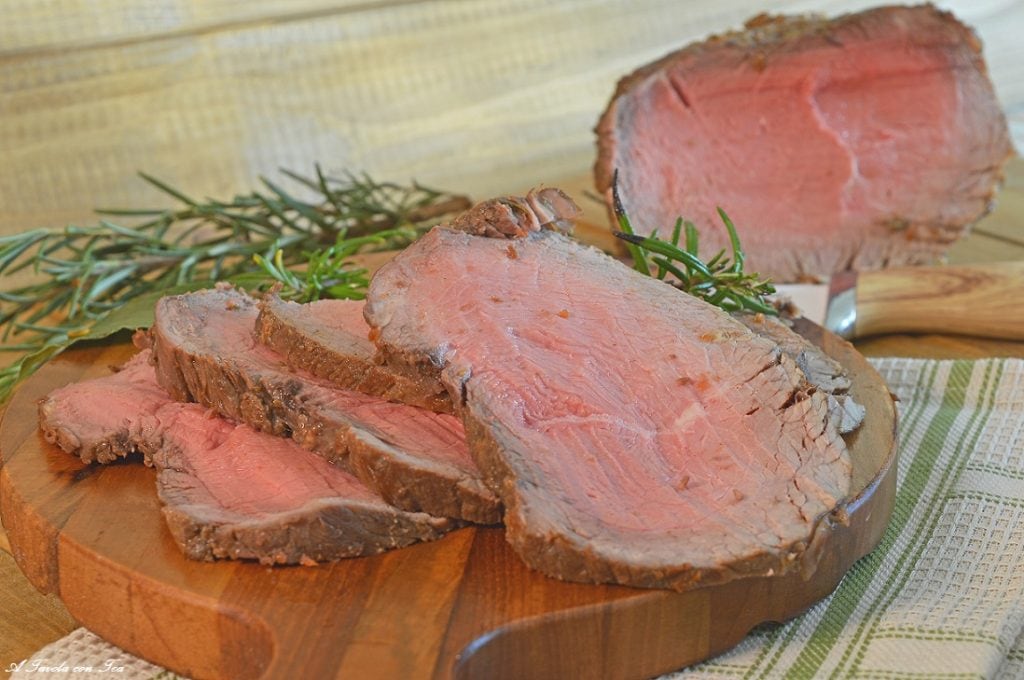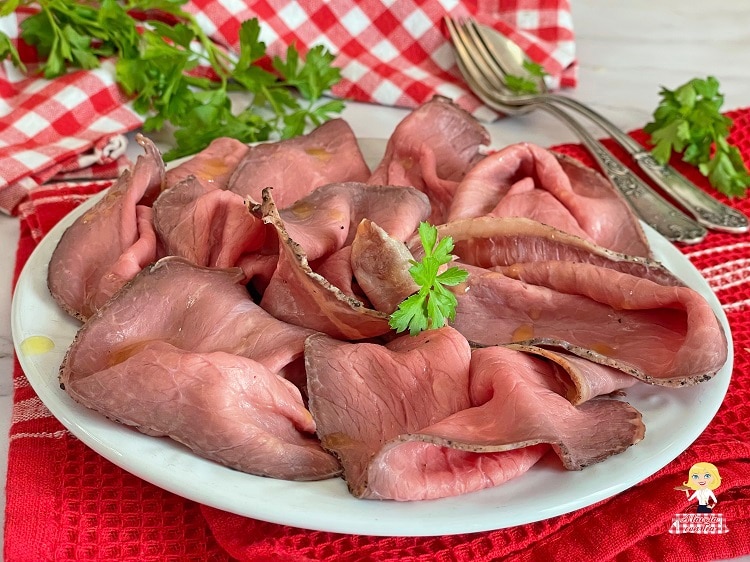Oven ROAST BEEF EASY foolproof recipe
I am 50 years old and this is the first time I have made ROAST BEEF in the oven and it turned out! The recipe I had been waiting for so long and finally found.
I admit I have never been particularly good at preparing roasts and roast beef, actually to be honest I have always been hopeless at it.
Maybe because at home, ever since I was a child, fish was always preferred to meat, which I saw being cooked in a thousand ways, while little attention was paid to anything else: now that I think about it, I don’t think I have ever seen my mother cook a roast in her life, no joke!
Once married, both my husband and son made it clear they loved meat, especially roast beef, and I tried several times to prepare it but with poor results.
You have no idea how many attempts I have made, but nothing changed: it was either too raw, overcooked, or tough as a shoe sole … I was about to give up when I stumbled almost by chance on this recipe and it was a revelation.
I can finally say that: I am 50 years old and this is the first time I have made Roast beef in the oven and it turned out! I followed the recipe exactly and it turned into the best roast I have ever tasted.
An infallible recipe, and if I managed it, believe me, anyone will be able to do it. A few simple tricks to obtain Roast Beef with flavorful, succulent meat, with little fat, slightly golden on the outside, worthy of the best rotisseries.
Moreover, you do not have to first seal the meat in a pan but will cook it entirely in the oven initially at a high temperature (this is a trick) and then lower it and continue until completion.
If you, too, have never managed to make a good Roast Beef and were about to throw in the towel, don’t! Make one last attempt and you will be amazed, and then I repeat if I managed, I assure you it’s a piece of cake.
So what are you waiting for? Try this perfect roast beef recipe

- Difficulty: Easy
- Cost: Medium
- Rest time: 15 Minutes
- Preparation time: 15 Minutes
- Portions: 8
- Cooking methods: Oven
- Cuisine: Italian
- Energy 315.71 (Kcal)
- Carbohydrates 8.83 (g) of which sugars 0.02 (g)
- Proteins 42.53 (g)
- Fat 13.39 (g) of which saturated 3.12 (g)of which unsaturated 0.01 (g)
- Fibers 0.17 (g)
- Sodium 3,160.83 (mg)
Indicative values for a portion of 200 g processed in an automated way starting from the nutritional information available on the CREA* and FoodData Central** databases. It is not food and / or nutritional advice.
* CREATES Food and Nutrition Research Center: https://www.crea.gov.it/alimenti-e-nutrizione https://www.alimentinutrizione.it ** U.S. Department of Agriculture, Agricultural Research Service. FoodData Central, 2019. https://fdc.nal.usda.gov
Ingredients
- 4 lbs Beef (cut for roast beef)
- 1/4 cup extra virgin olive oil
- 1 tablespoon rosemary (fresh chopped)
- 1 tablespoon Thyme (fresh chopped)
- 4 teaspoons fine salt (for coating)
- 1 teaspoon black pepper (freshly ground)
Tools
- Bowl
- Pan
Preparation
MEAT REST BEFORE COOKING Optional but recommended step.
Put the meat on a rack placed on a baking tray and leave it in the refrigerator uncovered for at least 1 hour. This little trick helps achieve an excellent crust and better browning. The air circulating inside the fridge dries the surface of the meat a little before the roast goes into the oven: this way it browns much faster. I know it sounds like nonsense but it works, anyway this step is optional, but I highly recommend it.
Preheat the oven to 450°F. While the oven reaches temperature, prepare the marinade for the meat. Mix the olive oil, garlic, rosemary, thyme, salt, and pepper in a small bowl. Pour it over the meat and massage the entire surface. Keep in mind the golden rule: 1 teaspoon of salt for every pound of beef and adjust accordingly depending on the size of your roast.
When the oven has reached temperature, put the meat to cook, but place it on a rack over a tray and not directly in contact with it so there is a small gap between the rack and the pan. If you have a probe to measure the internal temperature of the meat, now is the time to insert it; otherwise, any instant-read kitchen thermometer will do just fine, or even nothing at all!
Roast the meat for 15 minutes to start the browning. Then reduce the oven temperature to 320°F and continue cooking for about 1 hour and 30 minutes, 1 hour and 45 minutes maximum. If you have a meat probe, consider that the internal temperature should be around 130°F.At this point, you would be tempted to slice the meat and serve it right out of the oven. Don’t do it: the juices will escape from the roast. Instead, wrap the roast with aluminum foil and let it rest for 30 minutes to give the juices time to redistribute inside the roast. Transfer the roast to a cutting board and slice it thinly across the grain. And there you have it: tender roast beef with a beautifully deep golden crust.

TIPS:
TYPE OF MEAT: I use Beef, also because for a good roast beef you need to buy a large cut around 4 – 4.5 lbs, lean and of uniform shape. My favorite is the Eye Round but the Strip Loin, Topside or Rump also work well. In any case, if you have any doubts, always ask your butcher, he will advise you on the best cut he has on the counter at that moment.
OLIVE OIL: A little oil is necessary to turn the garlic and herbs into a paste that we can spread on the roast. The oil also conducts heat, promoting crust formation.
GARLIC: Garlic is important for giving flavor to your Roast Beef, but if you really can’t stand it or can’t digest it, you can omit it, but don’t forget to use aromatic herbs.
AROMATIC HERBS: I chose the classic combination of thyme and rosemary, but feel free to swap one of your favorite herbs (sage, parsley, oregano, etc.) or use dried ones if you prefer.
SALT: Large cuts of meat require a generous amount of salt. A good rule of thumb is to use 1 teaspoon of salt for every pound of beef.
BLACK PEPPER: Use freshly ground black pepper as it has a better aroma and flavor than the pre-ground one.
STORAGE
Leftover roast beef can be stored in an airtight container in the refrigerator for 3 or 4 days. To help the meat retain moisture, leave the leftovers unsliced until the moment you reheat them. To freeze, wrap leftovers in plastic wrap and store in a freezer-safe bag for up to 3 months.
What is the best cut of beef for roast beef?
There isn’t a single perfect cut of beef for making roast beef. The most commonly used beef cuts for Roast Beef come from the leaner parts of the animal. These include the round muscles, the top side, and the bottom side. The recommended beef cuts for preparing Roast Beef are typically the Strip Loin, the Eye Round, the Rump, the Knuckle, and the Topside. In any case, if you’re not sure, ask your butcher; they will guide you to the best available cut that day for preparing Roast Beef!
How long should I cook my roast beef?
It depends on two things: the size of your roast and the desired doneness. My roast of about 4 lbs was well-cooked for about 0.5 inch, and then the rest was pink after 1 hour and 30 minutes. If you want it medium, keep it in the oven (same weight) for 1 hour and 45 minutes. Roast Beef should not be overcooked; it should still maintain a pink part.
How do I use the thermometer to measure the internal temperature of the meat?
The best way to get an accurate reading of the internal temperature of the meat is to insert the thermometer deep enough to reach the center of the Roast Beef piece. For medium-rare, it should reach an internal temperature of about 130°F; for medium, the internal temperature should be around 145°F.
What to do with leftover roast beef?
One of my favorite ways to use leftover roast beef is in the classic sandwich with tartar sauce or tuna sauce and some lettuce leaves.

